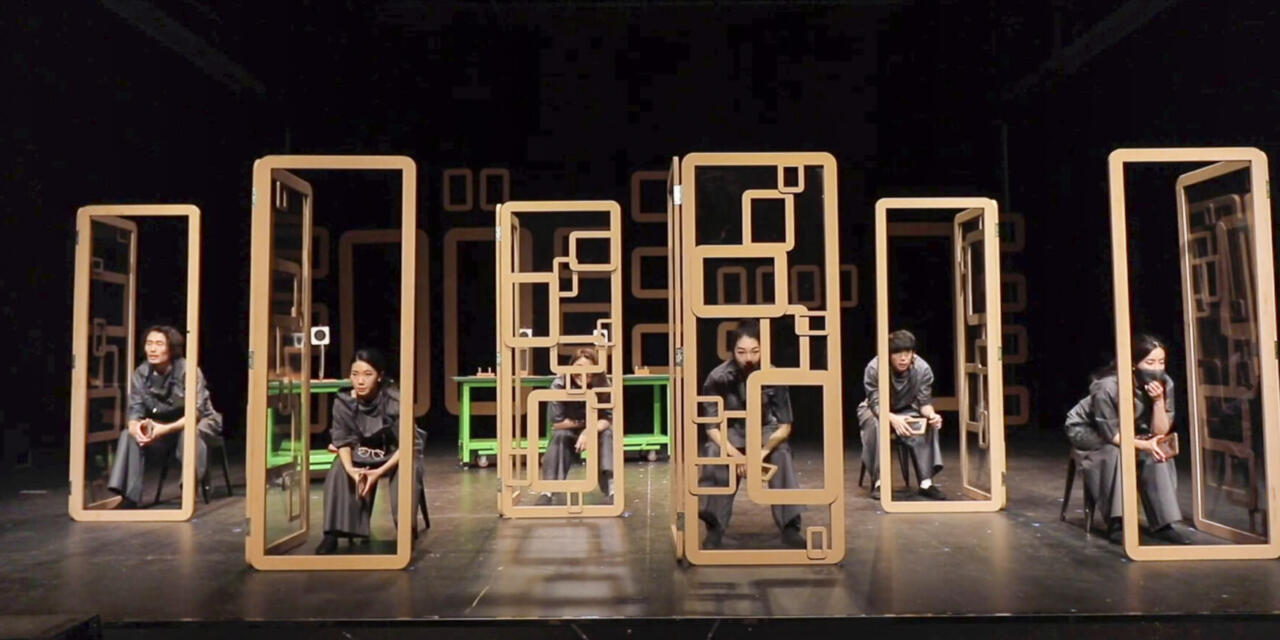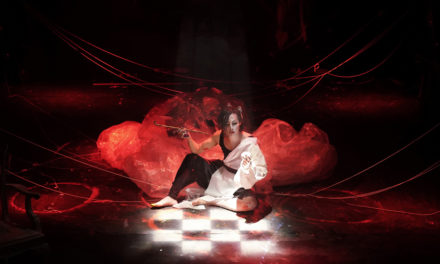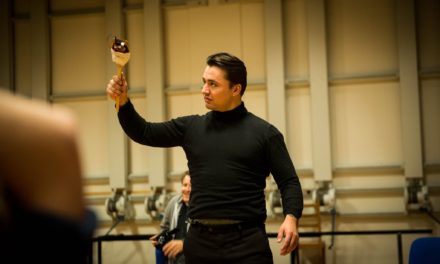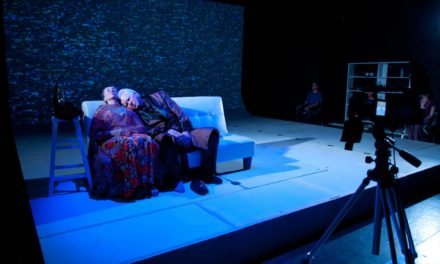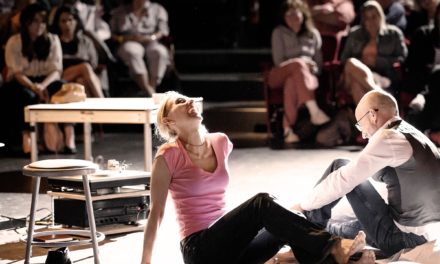The Legend of The Waitress & The Robber is a collaboration between the Korean theatre companies Playfactory Mabangzen and Yellow Bomb and the New York City-based Concrete Temple Theater. The piece is described as:
“Set in a dystopian society, The Legend of The Waitress & The Robber is a comic-book-style mash-up inspired by Friedrich Schiller’s play The Robbers and the Korean novel The Story of Hong Gildong, both Robin Hood-style stories of individuals betrayed by their families. With nods to Weill and Brecht, the characters sing and dance as they fight for what they believe, challenging the timeworn concepts of family and perceptions of ownership and justice.
The Waitress, fed up with watching her elderly customers be mistreated by their children, kidnaps these seniors so she can give them the care they deserve. Meanwhile, the Second Son, accused by his brother of being a thief, becomes a robber who ‘liberates’ people from the clutches of their cellular devices.”
The origin of this The Legend of The Waitress & The Robber goes back to 2017, when writer/director Renee Philippi received an Asian Cultural Council grant to study contemporary Korean theater practices. A meeting with members of Playfactory Mabangzen in Seoul in 2018 sparks the collaboration, which leads to several trips, workshops, and residencies across Seoul and NYC over the next few years. Finally, The Legend of The Waitress & The Robber will receive its world premiere performances at PS21-Chatham (May 21 – 22, 2022) and at Dixon Place (May 25 – 29, 2022) in New York City, in partnership with Korean Cultural Center New York (KCCNY). Written by Renee Philippi and directed by Renee Philippi and Eric Nightengale, with an original score by Lewis Flinn, this piece will be performed in English and Korean, with subtitles for both.
* Friedrich Schiller’s The Robbers was published in 1781 and premiered, with great success, in Mannheim, Germany, in 1782. Portraying the conflict between two aristocratic brothers and raising questions about liberty versus law, the play is regarded as an exemplar of the Sturm und Drang (Storm and Stress, approximately, 1770 – 1785) movement, which was a youthful, visceral, dynamic, and experimental movement in revolt against the rationalism of the Enlightenment and the rigid “rules” of Neo-classicism.
* The Story of Hong Gildong (Hong Gildong jeon) is a Korean novel, which was presumably written by Heo Gyun in the nineteenth century, during the Joseon Dynasty, and has achieved popularity and literary and cultural acclaim continuing to this day. The novel focuses on the heroics of Hong Gildong, an illegitimate son of a nobleman and a concubine, as he becomes a leader of a band of outlaws and steals from the rich. The novel inspired numerous adaptations in various popular forms, and the name Hong Gildong became a placeholder name, often used in templates for official documents.
Performers: Carlo Adinolfi, Rolls Andre*, Ju Yeon Choi, Hye Young Chyun, Nam Pyo Kim, Lisa Kitchens*, Eunji Lim, Yura Noh, James A. Pierce III*, and Kyongsik Won — *Appearing Courtesy of AEA
Directed by: Eric Nightengale and Renee Philippi
Associate Director: Jung-Wan Seo
Set Designer: Carlo Adinolfi
Musical Directors: Jacob Kerzner and Hee Eun Kim
Costumer Designer: Laura Anderson Barbata
Production Stage Manager: Quentin Madia
Concrete Temple Producer: Casey McLain
MBZ Artistic Director: Sun-Woong Koh
MBZ Producer: Kang-Min Ko
Yellowbomb Producers: Chan Lee & Jean Uh
Costume Associate: Matthieu Goedefroot
Subtitles: Jeongyun Lee
Interview with the Creative Team, conducted by Walter Byongsok Chon
What was the first inspiration for this piece? Could you describe how the idea for this piece occurred?
Renee Philippi (Writer, Co-Director, Co-Artistic Director Concrete Temple Theatre): The first inspiration for the piece came when working with my old and dear friend MiSun Choi, a founding member of Concrete Temple Theatre. We were collaborating to develop new work, and she was telling me the story and significance of seaweed soup in Korea. I was floored. My Mother is always very thoughtful on my birthday, but she does not make a soup for me on my birthday to commemorate my birth, a soup that she ate while I was in the womb to ensure my good health. From there, we talked about mothers who did not make seaweed soup for their Korean children and children who did not take care of their Korean parents or American parents.
In 2017, I was granted a fellowship from the Asian Cultural Council (ACC). I was in Korea in the spring of 2018 for 4 weeks. It was then that my relationship and collaboration with Playfactory Mabangzen and Yellowbomb was cemented. This was what I wrote in my ACC application: “I am applying to the Asian Cultural Council for an Individual Grant to conduct focused research on present day thoughts and attitudes towards aging and what it means to be “old” in Korea. Other related themes that will be the focus of my research are Korean attitudes towards women, past and present, as well as technology, contrasted with attitudes towards aging, women, and technology in the U.S. While in Korea, I will also research current and traditional Korean theatre and dance practices, and my investigations will become the basis for public theatrical performances.”
Chan Lee (Executive Producer/International Project Producer, Yellow Bomb): This project was initiated with an e-mail by Renee Philippi to the Korean Cultural Center NY about six years ago. We used to call this project “Renee Launches a Little Ball,” [after Cho Se-Hui’s popular Korean novel A Dwarf Launches a Little Ball (1978).] Renee asked Hyo Han, KCCNY’s Director of Performing Arts, for recommendations about Korean theatre companies for a possible cultural exchange, and Hyo connected Renee with Kang-min Ko, executive producer of Playfactory Mabangzen.
I was kind of “chilling” in New York City when Kang-min put me in touch with Renee. Renee, Carlo Adinolfi, Eric Nightengale, and I had our first meeting in a studio in the winter of 2017. Despite the differences in our theatre companies’ aesthetics, I believed we could complement each other well and found that we were getting along as artists. So I recommended our collaboration to Kang-min.
The next year, Kang-min visited New York for a meeting with Renee and Casey McLain (Production Coordinator). Kang-Min and Renee’s common interest in the issues of an aging society brought them close together, and they eventually agreed on our collaboration.
For the next few years, Concrete Temple Theatre and Playfactory Mabangzen visited each other in New York City and Seoul and developed our piece. As a freelancing producer for Mabangzen, my initial responsibility involved supervising the communication and the overall collaboration process between NYC and Seoul. This responsibility was handed over to the producers at Yellow Bomb since its foundation in 2018.
When I was first approached about this project, I was intrigued by the prospect of working with a theatre company based in the US. Then I observed, with great excitement, a puppetry workshop by Carlo Adinolfi during Concrete Temple Theatre’s visit to Playfactory Mabangzen, and I immediately said yes.*
How did you come up with the idea of putting together Schiller’s The Robbers, The Story of Hong Gildong, a comic-book style mash-up, and a musical? What interested you about the texts and stories of Schiller’s The Robbers and The Story of Hong Gildong?
Renee Philippi: Both of these texts have inspired the piece; I have not adapted them. I read The Story of Hong Gildong for the same developmental workshop with Misun. I have a deep love of German theatre, having worked at the Deutsches Theater in East Berlin prior to the re-unification of Germany. The Robbers by Schiller is one of my all-time favorite plays. I was struck by the similarities in the two stories; they both share the First Son versus a Second Son construct. Both stories are about justice and making visible those who are not often seen. From there, as I was thinking of Schiller, I started thinking of Brecht, Weill, and shows like The Threepenny Opera. From there, a comic book, stylized mash-up, and characters singing became part of the picture/concept.
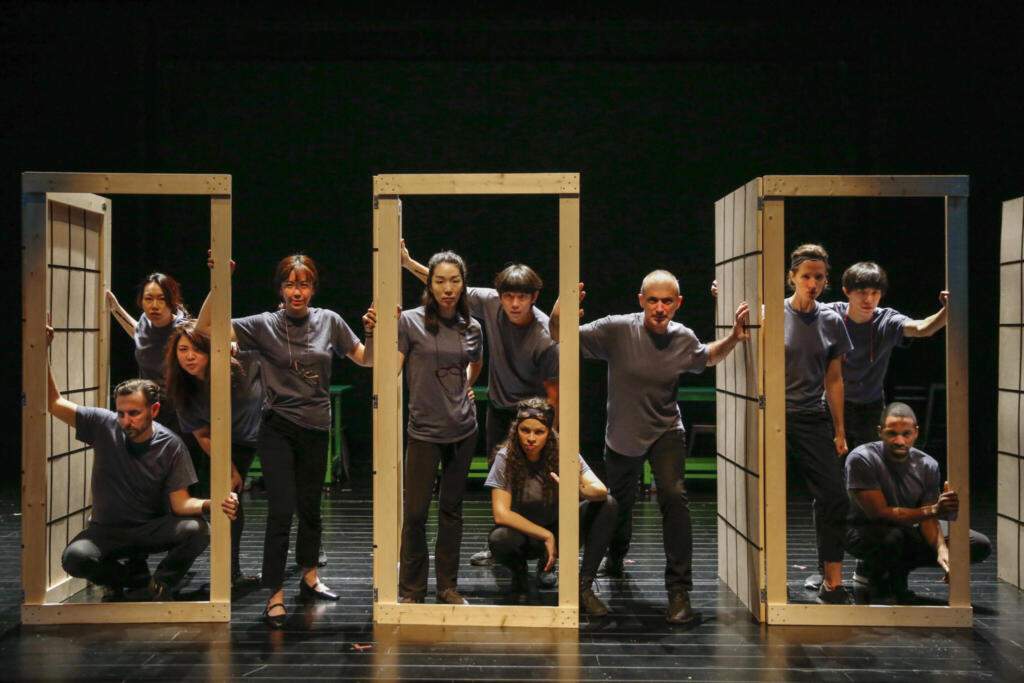
Go-Myung Son, Gabriel Grilli, Hye Young Chyun, Joo Youn Park, Ju Yeon Choi, Nam Pyo Kim, Jianzi Colon-Soto, Carlo Adinolfi, Lisa Kitchens, Sung-Hwan Lee, and Malcolm Jamal King. Photo Credit: Dong-Geun Kwak
How did you collaborate across continents? And how did you continue your collaboration during the pandemic? What were the biggest challenges? How did the piece further develop during the pandemic?
Renee Philippi: We, Concrete Temple Theatre, began collaborating with the Seoul-based theatre company, Playfactory Mabangzen, in 2018. In 2018 and 2019, we traveled to Seoul from NYC three times, and they visited us in NYC once, to progress our collaboration. All was in preparation for our April 2020 premiere of The Legend of The Waitress & The Robber.
In order to progress the development of the play, our Seoul colleagues would rehearse in Seoul, and then we would Skype (non-video) to discuss the notes from their rehearsals. They would videotape rehearsals and send the video, so we could watch it beforehand. We tried to set up ways for us to be in the room, while they were rehearsing, but this proved beyond anyone’s technical or financial capabilities.
After the premiere of the show was canceled in April 2020 because of Covid, we immediately tried to see what else was possible. The introduction and widespread use of Zoom suddenly made many things that were not possible, now possible. We decided to do a videotape version of the show, November-December 2020, sponsored by the Korean government. We each, Seoul Team and NYC Team, rehearsed and videotaped our scenes, and then all was spliced together. The video was released through KCCNY and in South Korea in January/February 2021 and was available online for about 6 months. We also organized, with KCCNY, a Zoom videotaped talkback with both teams
Jung-Wan Seo (Associate Director): The pandemic derailed our original NYC premiere. Initially, we were uncertain about the prospect of continuing our collaboration. Yet we soon found ways to work together through online meeting platforms. We each made videos of scenes with New York performers and with Korean performers and put them together for an online showing. We continued our rehearsals using each other’s videos. This process of collaborating across continents enhanced my interest in international collaboration and creating online performances.*
Could you talk about the development and rehearsal process?
Eric Nightengale (co-director/dramaturg): Developing a new theatrical piece is like throwing spaghetti at the fridge and seeing what sticks. It is inefficient, time-consuming, and sometimes painful. Often an idea needs to be fully realized before we understand it doesn’t work, requiring us to discard something into which a lot of time, money, and energy has been poured. But it’s a glorious way to grow a play, and no other process results in the kind of group commitment and deep ownership over choices that comes from a development process. In this final stage of re-discovering and finishing The Legend of The Waitress & The Robber, a lot of what is happening in rehearsal has to do with paring away stuff that has become unnecessary, because we now trust the material enough to simplify to the most powerful, engaging choices.
The piece is performed in English and Korean, with performers from both New York City and Korea. Could you share how you directed performers from different countries, cultures, languages, and possibly different trainings?
Eric Nightengale: Working with performers who speak different languages, and who come from a culture and history vastly different from our own is a great way to realize how many assumptions we rely upon in our day-to-day life in terms of communication. In rehearsal, we find ourselves constantly ‘checking in’ to make sure that what we think we are saying is actually what our Korean partners are hearing. We have also learned that there is a cultural difference in how American and Korean actors take notes. American actors often bristle if you give them a line reading (demonstrating exactly how you want the character to say the line) or ask them to copy and action: They want to discover that for themselves. Korean actors, on the other hand, want to be shown exactly how we think the character should say a line or perform an action. Then — after they have executed that precisely — they add subtle (or not so subtle) modifications to make the choices their own.
Were there particular challenges and rewards through the process? What did you find most rewarding about this international collaboration?
Renee Philippi: The humanity – the differences and the sameness!
Eric Nightengale: It’s a pleasure to be challenged and to learn new ways of working together. There are vast differences in how we see the world and interact with each other, but our similarities are more powerful than our differences. Negotiating solutions across cultural divides is sometimes maddening, but also extremely rewarding.
Jung-Wan Seo: Communication was the biggest challenge in the collaboration. This was less a matter of us being from different countries and using different languages. Since this was our first collaboration and we have different languages, gestures, and cultures, it took us time to get used to each other and to each other’s working methods. With our limited time together, the long adjustment period sometimes generated frustration and anxiety.
But once we got over our communication barriers and found harmony in our collaboration, we realized we shared a common, deep approach to the story we were creating and felt a growing camaraderie with one another.*
Ju Yeon Choi (Performer): Rehearsing in English at times prolonged the practice and rehearsal period. But Renee was very patient with the Korean performers and respectful of our experience. She was always open to listening to our opinions and frequently checked if we felt comfortable or if we understood her direction. This relationship, which was based on equality as collaborators and not hierarchy, made me feel like a true collaborator on this piece and helped me enjoy the whole process. Of course, the pandemic caused significant changes to the story we were creating. Nevertheless, as we were all going through it together, we were also able to find more commonalities as human beings, whether in the US or Korea and reflect that in the piece.*
Hye Young Chyun (Performer): The challenges in the process were unpredictable changes that happened due to life. The biggest reward would be the memories with the people given the opportunity to learn and experience under the influence of Concrete Temple Theatre, Playfactory Mabangzen, and Yellowbomb for a show that is in Korean and English. I am grateful for the positive vibes and laughter in the process.
Eunji Lim (Performer): When I first read the play, it somehow reminded me of the legends and fairy tales I had read when I was young. And I was super excited to be one of the heroic characters, even if I’m not specifically a “hero” character such as Hong Gil Dong. I still think we are all heroes in our own way from our play. It’s always a joy to read the story and to get immersed in the story where “the bad” gets comeuppance and “the good” who reflects justice gets victory because sometimes it gives us catharsis. But for some reason, it was rare to find the kind of stories I remembered from my childhood. That’s why I felt lucky when I read this play! And I am glad that I have this opportunity to be able to share the joy as well as catharsis I felt, through this story, with the audience. And in terms of the collaboration of actors, it can only be a marvelous experience to make stories together by sharing each other’s languages and artistic experiences.
Nam Pyo Kim (Performer): Considering that the inherently collaborative nature of theatre, made possible by the commitment of everyone involved, including directors, performers, and staffs, is not specific to certain countries or cultures, I wouldn’t say that the challenges in this particular international collaboration were anything out of the ordinary. One challenge was that, with the different languages, we oftentimes needed to use a translator, and that prolonged our process. As our piece is inspired by classics, I hope the audience will find the appeal in the familiarity and will also appreciate how our intensive research and discussions manifested in our piece.*
Yura Noh (Performer): The biggest challenge was the language. I started with memorizing the English text. But since English is not my first language, it was difficult to attach the accompanying emotion to the language. Getting the accent right also took a lot of effort. Yet the challenges made the process all the more rewarding whenever I figured things out.*
Kyongsik Won (Performer): The biggest challenge, I think, was sustaining the morale, with all the cancellations or postponements of schedules due to the pandemic. Whenever I encounter new works, directors, and environments, the trial and error more often than not turn into novelties than ordeals.*
Could you talk about your inspiration for and process of composing the score?
Lewis Flinn (Composer/Lyrics): We made a decision that the music would function primarily as a “Greek chorus,” serving a narratorial function- getting out exposition. All of these moments are treated in a “Kurt Weil” manner- with humor and a wink to the audience. There are several “character” songs that are set differently and are meant to reflect the emotions of the characters singing them. As with any piece, my main goal is to stay true to my own voice. Compositionally, I want to make sure the music and lyrics make sense for the characters singing them and sound appropriate for the setting of the play.
How was the design of this piece created?
Carlo Adinolfi (Set Designer, Performer, Co-Artistic Director Concrete Temple Theatre): The unstated conceit behind the production is that the performers are in some kind of detention center and have created the show to entertain their captors and the other inmates. As a result, there is no masking, the performers and musician are seen onstage the entire time, and they execute all the scene changes themselves, using just folding screens, rolling tables and stools. I designed the set to look like it was made by the cast with readily available materials, primarily magic marker and cardboard. In the show it is the law that everyone has a mobile device contract with “The Company,” and the company tracks their activities all the time, so I chose the iconic shape of a screened device as a recurring image, as if it was the company logo, its brand. We see it everywhere watching over everyone.
I also perform in the show as ‘Second Son’. It is fun playing the character’s somewhat naive outlook on the world and then his unfolding enlightenment.
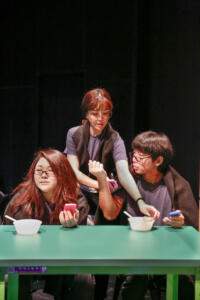
Hye Young Chyun, Joo Youn Park, Nam Pyo Kim. Photo Credit: Dong-Geun Kwak.
As a performer, how did you approach your role, considering the piece’s comic-book-style mash-up, its inspiration from Schiller’s The Robbers and The Story of Hong Gildong, and the international collaborative process?
Ju Yeon Choi: My character “Waitress” kidnaps elderly people out of her nostalgia for her grandmother, but she does not understand that generation well. Many Koreans, including me, were brought up by our grandmothers growing up. I approached my character thinking of my grandmother, who was loving but distanced and with whom I had a hard time communicating at times.*
Hye Young Chyun: Making sure not to come across as making fun of my characters.
Nam Pyo Kim: This piece contains all kinds of characters and lives, too many to elaborate on here. It also contains a part of me I have yet to experience. I focused on exploring various versions of myself as I tried to find myself in my character through critical self-reflection. Most of all, I tried to find truth and authenticity in my character.*
Eunji Lim: For me, It’s been a very interesting journey to approach a Korean elder lady, Okja, with my imagination and with having my young instrument. As you will see in our play, Okja has a daughter, and she has been through the hardship of a new world and new technology with her daughter and herself, but she still has a playful and pure personality and still tries to keep her own identity by making others comfortable, by trusting the waitress, and by naturally speaking in her mother tongue without being conscious of others. I’ve been trying to find the intersection between myself as an actor and Okja in terms of the physical side and mental side, regardless of our age gap, and I think I’m on my way to discovering our similar qualities as well as different perspectives, which is always a fruitful joy as an actor.
Yura Noh: This piece portrays elderly people whose every aspect of life is under surveillance and control and who dream of freedom. Many theatre and film stories present an oppressive reality and people who both conform to it but want to fight against it. I approached my role, connecting it with past roles I have played and exploring what they all shared.*
Kyongsik Won: When I sing, I sing as myself rather than my character and let the songs narrate themselves. After I sing, I show how I prepare for my role. Using only simple props, without makeup or costume, to portray an elderly person signifies that this is indeed theatre. Accordingly, my approach entails theatrical disguise and exaggeration.*
How do you feel now that you are finally going to share this piece with an audience, after several years of collaboration and waiting due to the pandemic?
Jung-Wan Seo: It’s been six years, whether that’s long or short. We’ve faced numerous challenges. But whenever we were rehearsing, we were all happy. I am grateful we can share our happiness with the New York audience, and I express my immense gratitude to our producers who stuck with us through thick and thin.*
Ju Yeon Choi: I am anxious and excited, especially considering how long the whole process took, including the development process through videos and showcases, and the cancellation of the original US premiere due to the pandemic. I am happy this piece will finally meet the audience.*
Hye Young Chyun: Scared?
Nam Pyo Kim: This piece reflects our dedication of over three years of preparation, discussion, and workshops as well as our hope and dreams. It portrays the present, the future, and the various questions we ask ourselves about our lives. I am excited that the audience can finally see all this.*
Eunji Lim: I am so blessed and feel so grateful for this project that I could be on stage with these amazing artists and especially with Korean actors in New York. It always made me feel special when I get a chance to share and act in my mother tongue, which is Korean, in a different country, and especially here in New York. I cannot wait to be on stage and tell stories with our team in Chatham and New York City.
Yura Noh: I feel a mixture of excitement and anxiety, probably because I do not know how the US audience would respond. But I trust Renee’s direction will be well conveyed.*
Kyongsik Won: After years of uncertainty, I am relieved and excited that this is finally happening.*
What kind of an experience would you like to create for the audience?
Jung-Wan Seo: In Tennessee Williams’s The Glass Menagerie, Tom goes to the movies every day. He immerses himself in them so that he could momentarily forget the harsh reality. Watching theatre, to me, means forgetting my reality and peeking into somebody else’s life in a different dimension (past, future, or different planet).
The Legend of the Waitress & The Robber is a story about people in a certain future. It is about being disconnected from the world, about the society controlled by technology, about getting old, about being human, and about what we can understand intellectually but not viscerally.
During the pandemic, we realized that the plague is not just something from Camus’s novel La Peste. There is more uncertainty for our future. Likewise, the future in our piece can be yours or mine. I hope that our piece can make you happy rather than melancholy, appreciate the present, and embrace the passing of time.*
Hye Young Chyun: An opportunity to connect.
Ju Yeon Choi: I hope the audience will appreciate this piece’s artistry, in addition to the unique US-Korean collaboration.*
Nam Pyo Kim: I don’t know, or rather, I cannot anticipate it. Rather than a particular experience, I hope that the experiences can be comprehensive and various. I cannot wait for this piece to meet the audience.*
Eunji Lim: I wish that our audience enjoys the story along with our show’s musical quality as well as the beautiful collaboration beyond linguistic and cultural differences. I also hope our audience has a chance to empathize with characters living in the world that could possibly reflect our distant or near future. Lastly, I hope our audience gets a chance to experience the beauty of the Korean language by hearing our story.
Yura Noh: I hope the robber king’s courage will give the audience courage and hope for a better future. I also hope the love story will warm their hearts.*
Kyongsik Won: I hope the audience will embrace and support how we view and care about the world.*
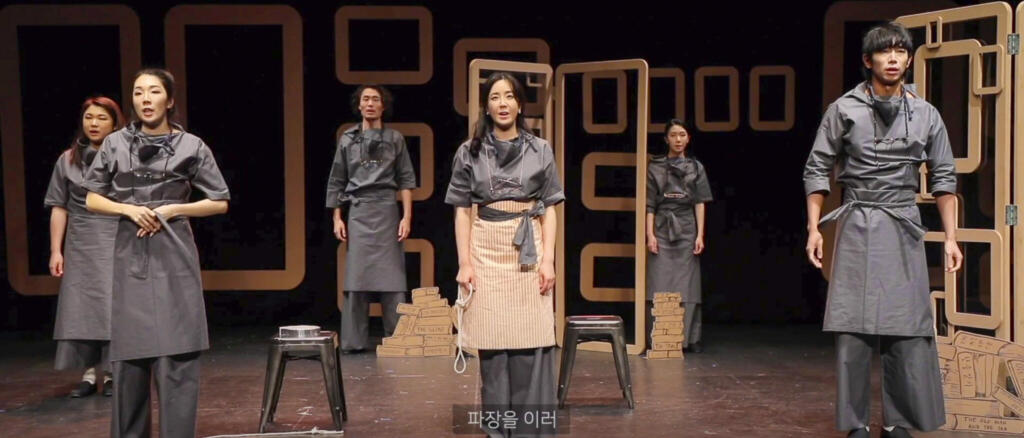
Hye Young Chyun, Ju Yeon Choi, Kyongsik Won, Joo Youn Park, Yura Noh, and Nam Pyo Kim. Photo Credit: Yong Sang Park.
Having worked on this piece, are you looking forward to doing more international collaboration? Are there particular countries, theatre companies, or kinds of works that interest you?
Renee Philippi: Yes, I am so looking forward to more international collaboration. International collaborations are very important to Concrete Temple Theatre and to me personally.
We have toured internationally: London, Sri Lanka, India, Bulgaria, Turkey, Italy, Scotland, South Korea, and Costa Rica.
After The Legend of The Waitress & The Robber, we will be collaborating with Seoul-based Yellowbomb (one of the Korean producers of W&R) to take PACKRAT, our all puppet-play, on its inaugural Southeast Asian tour with a Seoul and NYC cast.
Eric Nightengale: I’d love to learn more about early performance traditions in Asian countries – how they have been kept alive and relevant, how they have adapted, and how they have impacted modern theatrical storytelling.
Jung-Wan Seo: There is a bright prospect for international collaboration. We meet each other through plays and stories as directors, actors, and staff. It doesn’t matter which country we are from. I believe more international collaboration can and should happen. I look forward to working more with companies in other countries, any company with which we can create a story together, especially a story about humanity and how people live.*
* These interviews were translated from Korean into English by Walter Byongsok Chon.
* The photos are from previously performed versions of The Legend of The Waitress & The Robber.
Thank you so much for creating this piece and for taking your time for this interview! Congratulations on the premiere!
About Concrete Temple Theatre
CONCRETE TEMPLE THEATRE is a multi-disciplinary company, committed to the creation of compelling new theatrical works, incorporating drama, dance, puppetry, music, and the visual arts. Since 2004, Concrete Temple Theater has created devised visual theater that challenges the traditional relationship between design and text. Through touring original works and presenting workshops in NYC, nationally and internationally, they strive to bring myth and ritual back to the center of dialogue, by presenting works and workshops that address real issues within communities (grief, family relationships, environmental stewardship). They have presented their work for NYC audiences at venues like Ohio Theatre, HERE, and Barrow Street Theatre and have been artist-in-residence in NYC at The Flea Theater, Dixon Place, Mabou Mines, St. Ann’s Warehouse and chashama. Concrete Temple has toured work nationally at venues like The Yard, Bard Summerscape, Detroit Institute of Arts, Pontine Theatre, Dairy Center for the Arts, Amphibian Stage Productions and internationally: London, Sri Lanka, India, Bulgaria, Turkey, Italy, Scotland, S. Korea and Costa Rica. www.ConcreteTempleTheatre.com
About Playfactory Mabangzen
In 2005, PLAYFACTORY MABANGZEN (MBZ) was founded by Playwright and Director Koh Sun-Woong. A seeker of magical realism, Koh is interested in writing about the strange realities and characters of the world. Playfactory Mabangzen’s aim is to find that which lies at the core of the piece, the essentiality, and recreate it. Currently, Playfactory Mabangzen actively works locally in South Korea and abroad. MBZ believes that “the value of pursuing a combination of illusions and fantasies in a realistic world” is the way in which plays can secure meaning in this age. Awards include: 2018: Gyeonggi Arts Performing Festa Best Collection 4, “The Tale of Rabbit,” 2017: Geochang Summer Festival of Theatre, Best Play, Best Actor (Lim Jin-gu),“Human Cannonball Show,” 2016: Gimcheon International Theater Festival for Family, Best Play, Best Director, Best Actor (Lim Jin-gu), “Human Cannonball Show” and SAC Awards, Best Play, Best Director, “Hong Do,” 2015: E-daily Culture Awards, Best Play, “Hong Do” and Gyeonggi Arts Performing Festa Best Collection 3, “Hong Do,” 2012: The Korea Shakespeare Awards, Best Play, “Killbeth.”
About Yellow Bomb Inc.
Yellow Bomb Inc. is a multi-cultural company providing a new experience where culture meets another culture, expanding its cultural business domestically and internationally. Based on Korean traditional music and musical theatre, the company has successfully organized, arranged, and planned many global events and performances. The company seeks to expand its business as a global event organizer.
This post was written by the author in their personal capacity.The opinions expressed in this article are the author’s own and do not reflect the view of The Theatre Times, their staff or collaborators.
This post was written by Walter Byongsok Chon.
The views expressed here belong to the author and do not necessarily reflect our views and opinions.

